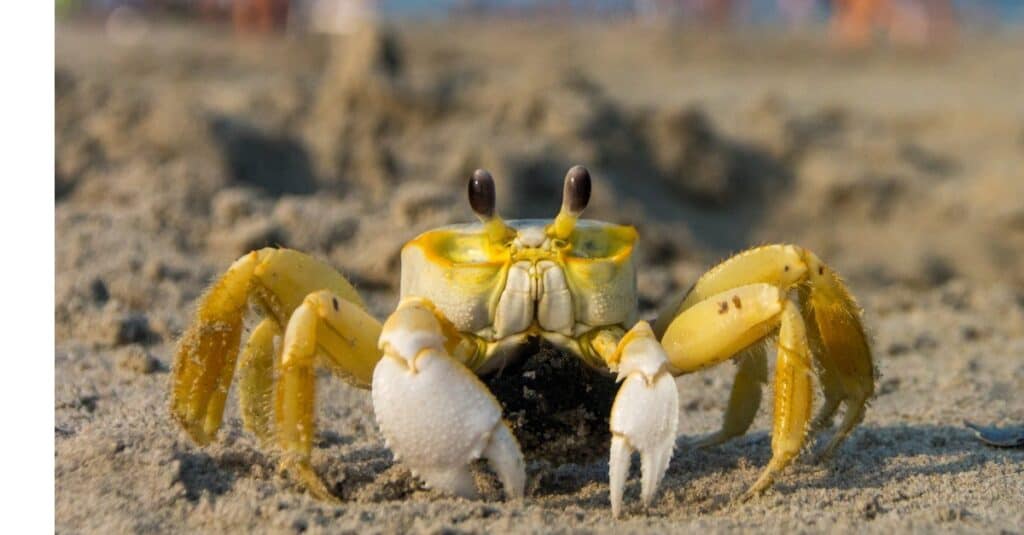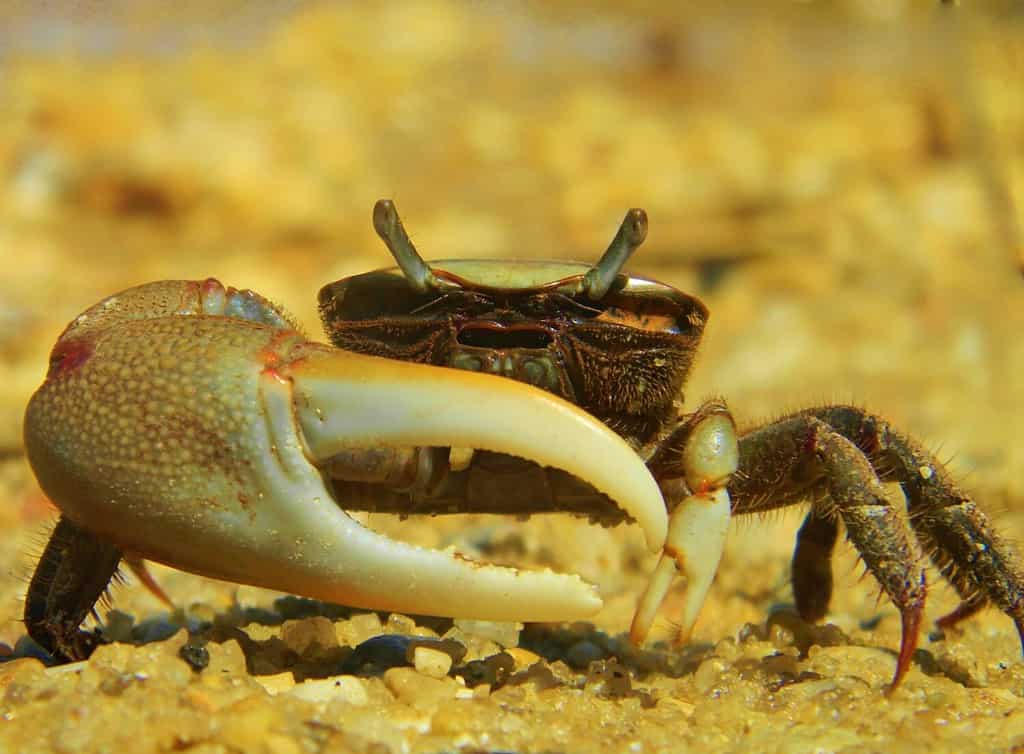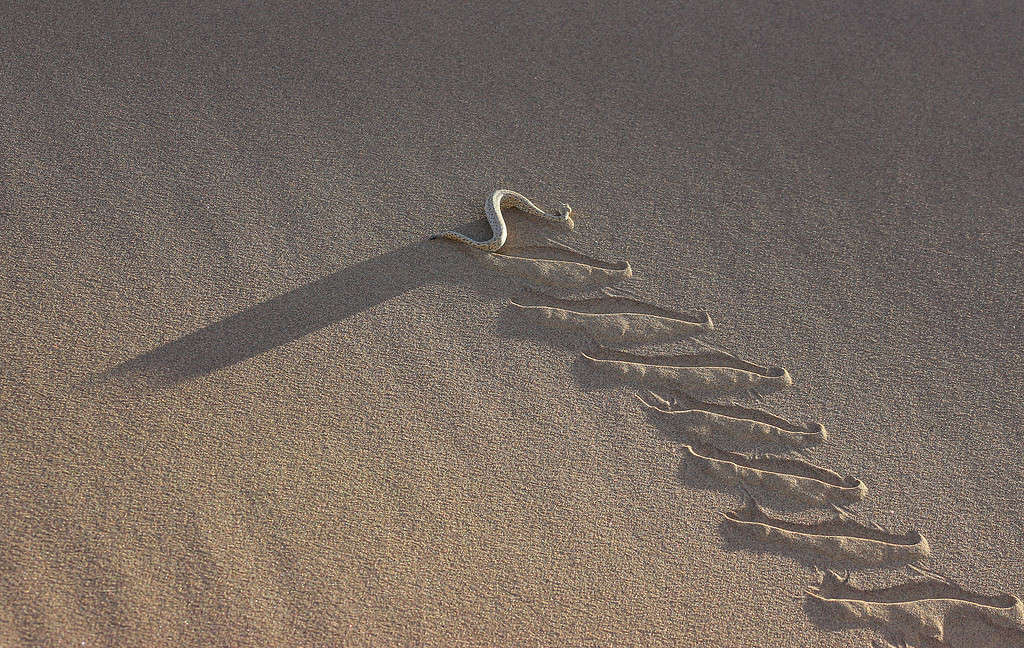Discover the fascinating secret behind crabs’ distinctive sideways walking in this intriguing article. Delve into the evolutionary wonders of these remarkable creatures as we explore why they have adopted such a unique locomotion pattern. Uncover the hidden reasons that have shaped their sideways scuttle and gain a deeper understanding of nature’s extraordinary adaptations. If you have ever wondered why crabs walk sideways, you have come to the right place. Let’s get started!
What is a Crab?

Many types of crabs run and walk faster if they move their limbs sideways.
©Shannon West/Shutterstock.com
Crabs are a type of crustacean belonging to the decapod group. They have a broad, flat body with a hard outer shell, also known as an exoskeleton. This shell is usually red, brown, or green in color and is typically covered in bumps or spines.
Crabs typically feed on a variety of marine plants and animals, including algae, mollusks, worms, and other crustaceans. They use their powerful claws to tear apart their prey and are also known to scavenge for food.
Crabs inhabit a wide variety of environments, from shallow-water estuaries and mangroves to intertidal and deep-water areas. Certain species are also found in freshwater habitats in tropical and subtropical regions.
Types of Crabs

There are thousands of different types of crabs all over the world.
©iStock.com/ANDREYGUDKOV
Crabs are one of the most diverse creatures in the ocean. They come in various sizes, shapes, and colors and can be found in coastal waters all around the world.
One of the most common types of crabs is the hermit crab. These crabs live in shallow coastal waters and have a soft, asymmetrical body that is protected by a shell. They usually feed on small mollusks and detritus.
Another type of crab is the fiddler crab. It is a small, land-dwelling crab with one large claw and one small claw. Fiddler crabs are omnivores and scavengers that feed on algae, worms, and small bits of organic matter.
Blue crabs are also popular and can be found in the waters around the eastern United States. They have a blue-green shell and large claws. They feed on small fish, mollusks, and other crustaceans.
The king crab is another type of crab, which is actually a species of lobster. They have a red shell, long spindly legs, and large claws. They feed on small fish and mollusks and are found in the cold waters of the North Pacific.
Crabs are an interesting species of marine life and come in all shapes and sizes. Whether they’re land-dwelling or living in the ocean, they’re sure to add beauty and diversity to the aquatic environment.
Why Do Crabs Walk Sideways?

A
ghost crab
is able to run five feet sideways per second!
©iStock.com/Jonathan Mauer
The shape of a crab’s body has evolved over time to give it a wide and short shape, while its belly is narrow and small. This unique anatomy means that the legs are located on each side of its body, which restricts movement in both its ‘shoulder’ joint and knees. As a result, crabs are able to shuffle slowly forward, but their fastest way of moving is by flexing the second joint of each leg sideways.
The main explanation for why crabs tend to move sideways is that it allows them to maneuver more easily in various environments. This helps them to traverse rocky or unstable surfaces, like the bottom of bodies of water, with greater ease. Since crabs are not particularly efficient swimmers, they rely on their sideways walking to navigate through sand and rocks and even climb trees.
Why Can’t Crabs Walk Forward?

Did you know crabs are able to walk forwards? They just prefer going sideways because it is easier and faster.
©Jennifer Nicole Buchanan/Shutterstock.com
Actually, they can! Crabs are able to slowly shuffle forward. Contrary to popular belief, crabs are not inherently incapable of walking forward. In fact, their sideways movement is primarily driven by efficiency rather than a physical limitation. While it may appear that these crustaceans exclusively scuttle laterally, the truth is that they possess the ability to move in a straight line when necessary.
So why do crabs predominantly opt for sidestepping? The answer lies in the mechanics of their joints and locomotion. Walking sideways allows crabs to capitalize on the unique structure and flexibility of their appendages, making it a faster and more effortless mode of transportation for them.
Intriguingly, when navigating across various terrains or searching for food sources, moving sideways offers distinct advantages over straightforward motion. By shuffling laterally, crabs can maintain better balance and stability while simultaneously utilizing all their legs to propel themselves in unison. This synchronized lateral movement enables them to swiftly maneuver through intricate habitats such as coral reefs or rocky shores with minimal effort.
However, despite this preference for sideward mobility, crabs possess remarkable adaptability in terms of directional travel. When faced with specific circumstances or obstacles that necessitate it—be it an imminent threat or an enticing prey—they are fully capable of propelling themselves directly ahead if required.
Do All Crabs Walk Sideways?

Hermit crabs are able to walk forward more easily than other types of crabs.
©Lauren Suryanata/Shutterstock.com
Most crabs are known for their distinctive sideways walk, a characteristic that sets them apart from other creatures. However, there are exceptions to this rule within the crab kingdom. Some species have evolved unique adaptations that allow them to walk forwards, defying the typical sideways scuttle.
One such exception is the lumbering spider crab, an impressive creature equipped with sharp tips on its legs. These specialized appendages enable spider crabs to effortlessly navigate sheer rock faces by gripping onto every crevice they encounter. Unlike their sidestepping counterparts, these formidable climbers prefer a more direct approach as they traverse treacherous terrains.
Another fascinating example of forward-walking prowess can be found in hermit crabs. Instead of relying solely on their legs for locomotion, as most crabs do, hermit crabs carry their seashell homes around on their backs. This unconventional mode of transportation allows them to move forward without hindrance or discomfort caused by dragging cumbersome shells along the ground. By embracing this ingenious lifestyle choice, hermit crabs demonstrate an alternative method of movement within the crab community.
Decorator crabs further challenge our conventional understanding of crab locomotion patterns by also exhibiting a preference for walking forwards instead of sideways. Diverging even further from what we might consider “ordinary” in terms of appearance and behavior, decorator crabs possess rounded pear-shaped bodies rather than the flattened form typically associated with traditional crustaceans.
Crab Anatomy

Crabs have unique and incredible anatomy.
©Mike Raube-Boyer/Shutterstock.com
It is noteworthy to explore the aspects of a crab’s anatomy. We will focus on their legs and why they move the way they do. Crabs have ten legs (decapods) situated half on either side of their body. The first pair is located near the front and has adapted to serve as pincers, giving them a way to hunt and protect themselves. Additionally, the fiddler crab has a larger front claw than the others.
The shell-like exoskeleton of a crab is the main reason why they walk sideways. It is much easier for them to move in this way due to the size of their shells. Even though crabs usually move in this fashion, they are still able to rotate their bodies if needed. By walking sideways, crabs are able to protect and shield the vulnerable areas of their bodies from danger.
Are Crabs The Only Animals That Walk Sideways?

Crabs are not the only animal that can move sideways quickly. Check out this snake!
©Chantelle Bosch/Shutterstock.com
The sidewinder snake, also known as the horned rattlesnake, is an animal that moves sideways rather than forward, like most other snakes. To move in this way, the sidewinder snake uses its unique anatomy. It has an S-shaped looping motion that allows it to move quickly across the ground. Its scales are adapted to grip the surface of the sand, and its body is designed to roll and undulate as it moves.
The sidewinder snake’s unique movement is an adaptation to the desert environment in which it lives. By moving sideways, the snake can avoid being seen and can also move quickly across the hot sand. The sidewinder snake can reach speeds of up to 8 miles per hour.
Naked mole rats do not move sideways. But they have a unique ability to move backward just as easily as they can move forward! This is made possible by their remarkably strong hind legs, which are specifically designed to allow them to both push off and pull against the ground in order to move in different directions. Unlike many other animals, naked mole rats use a “crawling” motion to move both forward and backward instead of a bounding or “jumping” motion. This means they can move smoothly and quickly in either direction without having to stop and turn around. They also have powerful claws on their feet that help them grip the ground and give them additional traction when they need to change directions quickly.
The photo featured at the top of this post is © davemhuntphotography/Shutterstock.com
Thank you for reading! Have some feedback for us? Contact the AZ Animals editorial team.






